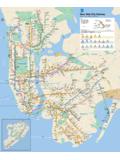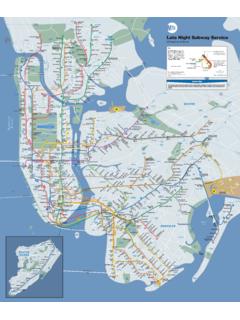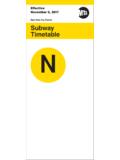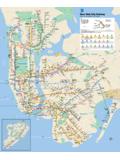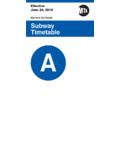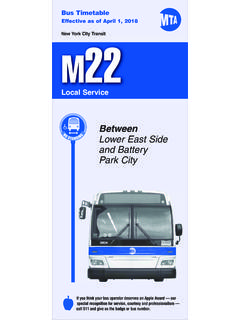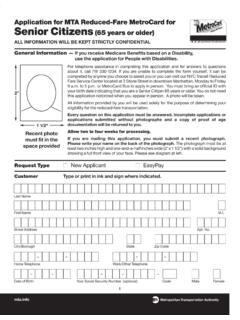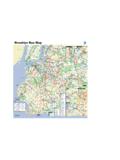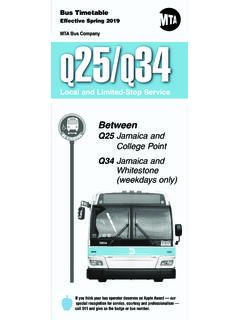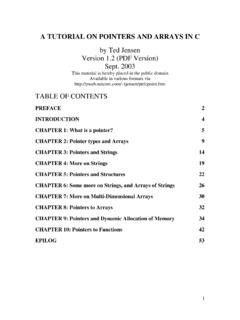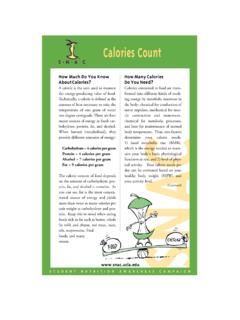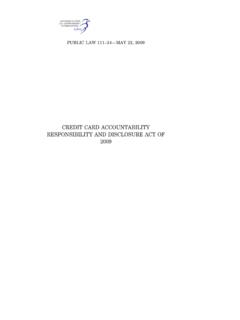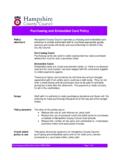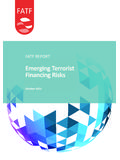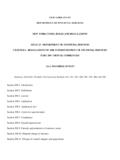Transcription of Rules of Conduct & Fines - MTA
1 Rules of Conduct & Fines MTA Rule MTA Offense Description Fine NYCTA Rule NYCTA Offense Description Fine Requiring persons to wear masks $50 (a)Litter, spit, urinate, or defecate $100 (b) Smoke, open flame, vape $50 NYCTA Rule NYCTA Offense Description Fine (c) Sleeping where hazardous $50 (a) Entered without payment $100 (d) Gambling $50 (b) (Reserved) ( ) (e) Unnecessary noise $50 (c) Unauthorized sale of fare media $60 (f) Throwing objects $75 (d) Unauthorized use of fare media $75 (g) Drinking alcohol $50 (a) Graffiti or other defacement $75 (h) Impaired by alcohol or drugs $50 (b) Posting notices of signs $25 (i) Breach of peace $50 (c) Non-transit use $50 (j) Obstruction of seating, facilities, elevators, escalators $50 (a) Obstruction of operations or traffic $100 (k)Commission of harmful acts $100 (b) Unauthorized commercial activity $50 (a)Carrying a weapon $100 (c)1 Activity in prohibited area (including > 1hr in fare zone) $25 (b) Carrying explosives $100 (c)2 Interfering passenger movement $25 (a)Entering restricted area $50 (c)3 Activity near construction $25 (b) Unauthorized parking $50 (c)4 Excessive noise $25 (c) Unauthorized photography or film $25 (c)5 Media device $25 (d) Use end door or pass between cars $75 (c)6 Sound production device $25 (e)
2 Extending body or item out vehicle$75 (c)7 Misrepresent affiliation $25 (f) Unauthorized entrance or exit $50 (d)1 Violating Lawful Orders $50 (g)1 Carrying long object $75 (d)2 Disregard sign or notice $50 (g)2 Carrying obstructive objects (including carts > 30 inches) $75 (d)3 ID Rule n/a (g)3 Carrying hazardous objects $75 (e) Interfere wheelchair facility $50 (h) Unauthorized animals $25 (f) Carrying open liquid $25 (g) Misrepresentation as agent $50 (h) Governor declared disaster (requiring passengers to leave) $100 Requiring Persons to Wear Masks (a) This Section subpart wholly supersedes the emergency mask Rules adopted and readopted by the following authorities: Part (d)(1) (adopted by the New York City Transit Authority and the Manhattan and Bronx Surface Transit Operating Authority); Part (g) (adopted by the Staten Island Rapid Transit Operating Authority); Part (f)(adopted by the MTA Bus Company); Part (g)(adopted by the Metro-North Commuter Railroad Company); and, Part (e)(adopted by the Long Island Rail Road Company).
3 (b) Every person on or in any terminal, station, train, facility, or conveyance (as those terms are defined in Parts 1040, 1044, 1050, 1085, and 1097 of this Subchapter) of any authority covered by this Part shall wear a mask that completely covers their mouth and nose. A mask should fit snugly but comfortably against the face and be secured to the head, with ties, ear loops, or elastic bands behind the head. A gaiter must have two layers of fabric or be folded to make two layers. Masks may be either manufactured or homemade and must be a solid piece of material without slits, exhalation valves, or punctures. Cloth masks should be made with two or more layers of breathable fabric that is tightly woven ( , fabrics that do not let light pass through when held up to a light source). Masks may be reusable or disposable. Medical masks and N-95 respirators fulfill this requirement. The following do not meet this requirement: (i) masks worn in a way that does not cover the nose and mouth (ii) face shields or goggles (though face shields or goggles may be worn to supplement a mask that meets the above required attributes) (iii) scarves, ski masks, balaclavas, or bandannas (iv) shirt or sweater collars ( , turtleneck collars) pulled up over the mouth and nose (v) masks made from loosely woven fabric or that are knitted ( , fabrics that let light pass through) (vi) masks made from material that is hard to breathe through (such as vinyl, plastic or leather) (vii) masks containing slits, exhalation valves or punctures.
4 (c) The requirement to wear a mask shall not apply under the following circumstances: (1) while eating or drinking for brief periods, but only in locations where eating and drinking otherwise are permitted, or while taking medication; prolonged periods of mask removal are not permitted for eating or drinking, the mask must be worn between bites and sips (2) while communicating with a person who is hearing impaired when the ability to see the mouth is essential for communication (3) while a person is unconscious (for reasons other than sleeping), incapacitated, unable to be awakened, or otherwise unable to remove the mask without assistance (4) when necessary to temporarily remove the mask to verify one s identity or when asked to do so by any police officer, peace officer, or authority employee. (d) The following categories of persons are not required to wear a mask: (1) a child under the age of two years; (2) a person with a disability who cannot wear a mask, or cannot safely wear a mask, because of the disability as defined by the Americans with Disabilities Act; (3) a person for whom wearing a mask would create a risk to workplace health, safety, or job duty as determined by applicable workplace safety guidelines or federal regulations.
5 (e) Any person who does not comply with the requirement to wear a mask that completely covers their mouth and nose may be barred from entering or remaining on or in any terminal, station, train, facility, or conveyance of any authority covered by this Part and also may be fined $50 per occurrence. This rule shall be enforced by each of the authorities on or in its terminals, stations, trains, facilities, or conveyances by any person authorized by such authority to enforce its own Rules and pursuant to the procedures established by such authority for enforcing violations of its Rules . Rules governing the Conduct and safety of the public in the use of the facilities of the New York City Transit Authority and Manhattan and Bronx Surface Transit Operating Authority Authorization and purpose (a) The provisions of sections 1203-a(3) and 1204 (5-a) of the Public Authorities Law provide the New York City Transit Authority and Manhattan and Bronx Surface Transit Operating Authority with the power to make Rules governing the Conduct and safety of the public in the use and operation of the transit facilities of those authorities.
6 (b) These Rules are established by the New York City Transit Authority and Manhattan and Bronx Surface Transit Operating Authority to promote safety, to facilitate the proper use of the transit facilities of the authorities, to protect those transit facilities and their passengers, and to assure the payment of fares and other lawful charges for the use of their systems. (c) These Rules may be amended or added to, from time to time, at the sole discretion of the New York City Transit Authority or Manhattan and Bronx Surface Transit Operating Authority in accordance with law. Definitions The following terms as used in these Rules shall have the following meanings: (a) Authority means collectively the New York City Transit Authority and its subsidiary, Manhattan and Bronx Surface Transit Operating Authority, public benefit corporations of the State of New York, except if the context in which the word authority is used indicates that it is either (but not both) New York City Transit Authority or Manhattan and Bronx Surface Transit Operating Authority to which reference is being made.
7 (b) Facilities includes all property and equipment, including, without limitation, rights of way and related trackage, rails, signal, power, fuel, communication and ventilation systems, power plants, stations, terminals, signage, storage yards, depots, repair and maintenance shops, yards, offices and other real estate or personalty used or held for or incidental to the operation, rehabilitation or improvement of any rapid transit railroad or omnibus line of the authority. (c) Service animal means a guide dog, signal dog, or other animal individually trained to perform one or more specific tasks for the benefit of a person with a disability, including a physical, sensory, psychiatric, intellectual, or mental disability, that such person is unable to perform due to such disability, such as guiding persons with impaired vision, alerting persons with impaired hearing to sounds, pulling a wheelchair, retrieving dropped items, recognizing or avoiding hazards, alerting a person to an oncoming seizure, and responding to a seizure.
8 The term service animal does not include a therapy animal, comfort animal, or animal used for emotional support. (d) Sound production device includes, but is not limited to, any radio receiver, phonograph, television receiver, musical instrument, tape recorder, cassette player, compact disc player, speaker device or system, and any sound amplifier or any sound-producing device of similar nature. (e) Conveyance includes any subway or rapid transit car or train, locomotive, omnibus or other vehicle previously used or held for use by the authority as a means of transportation of passengers. (f) Rules means these Rules . (g) Person means any individual, firm, partnership, corporation, association or company. (h) Fare means the lawful charges established by the authority for the use of its facilities. (i) Fare media means the various instruments issued by or on behalf of the authority to use for the payment of fare, including, but not limited to, farecards, passes, transfers, tickets, and vouchers.
9 (j) Farecards include, but are not limited to: (1) value -based, magnetically encoded cards (frequently referred to as pay-per-ride MetroCards) containing stored monetary value from which a specified amount of value is deducted as payment of a fare; and (2) time-based, magnetically encoded cards (frequently referred to as unlimited ride MetroCards) which permit entrance into facilities and conveyances for a specified period of time. (k) Payment of the fare includes the use at a fare collection device of a time-based farecard for purposes of gaining lawful entry into a facility or conveyance. (l) Paid fare zone means the area beyond the point at which a fare is required on a conveyance or within a facility. (m) MTA means the Metropolitan Transportation Authority and its subsidiaries and affiliates. (n) Police officer means any person so designated pursuant to New York Criminal Procedure Law, section who, pursuant to their authority, has jurisdiction within the facilities or conveyances of the authority including without limitation any member of the MTA Police Department, and also any Bridge and Tunnel Officer authorized to issue notices of violation pursuant to New York Public Authorities Law, section 553(7-a).
10 Construction In interpreting or applying the Rules , the following provisions shall apply: (a) The authority reserves the right from time to time to suspend, modify or revoke the application of any or all of the Rules as it deems necessary or desirable. (b) Any act otherwise prohibited by any of the Rules is lawful if specifically authorized by agreement, permit, license, or other writing duly signed by an authorized officer of the authority or the MTA or if performed by an officer, employee or designated agent of the authority or the MTA acting within the scope of their employment or agency. (c) Rules shall apply with equal force to any person assisting, aiding or abetting another, including a minor, in any of the acts prohibited by the Rules or assisting, aiding or abetting another in the avoidance of any of the requirements of the Rules . (d) The order or judgment of a court or other tribunal of competent jurisdiction that any provision of the Rules is invalid shall be confined in its operation to the controversy in which is* was rendered and shall not affect or invalidate any other provision of the Rules or the application of any part of the Rules to any other person or circumstances; the provisions of the Rules are declared to be severable.
